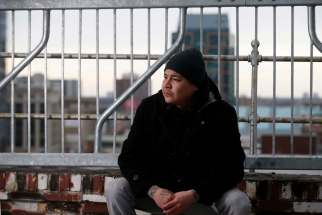Province bets on new COVID restrictions, gambles with Manitobans’ lives
Read this article for free:
or
Already have an account? Log in here »
To continue reading, please subscribe:
Monthly Digital Subscription
$0 for the first 4 weeks*
- Enjoy unlimited reading on winnipegfreepress.com
- Read the E-Edition, our digital replica newspaper
- Access News Break, our award-winning app
- Play interactive puzzles
*No charge for 4 weeks then price increases to the regular rate of $19.00 plus GST every four weeks. Offer available to new and qualified returning subscribers only. Cancel any time.
Monthly Digital Subscription
$4.75/week*
- Enjoy unlimited reading on winnipegfreepress.com
- Read the E-Edition, our digital replica newspaper
- Access News Break, our award-winning app
- Play interactive puzzles
*Billed as $19 plus GST every four weeks. Cancel any time.
To continue reading, please subscribe:
Add Free Press access to your Brandon Sun subscription for only an additional
$1 for the first 4 weeks*
*Your next subscription payment will increase by $1.00 and you will be charged $16.99 plus GST for four weeks. After four weeks, your payment will increase to $23.99 plus GST every four weeks.
Read unlimited articles for free today:
or
Already have an account? Log in here »
Hey there, time traveller!
This article was published 27/04/2021 (1695 days ago), so information in it may no longer be current.
There’s a race on between vaccines and variants, and the variants are winning, Premier Brian Pallister declared Monday.
What the premier didn’t tell Manitobans is there’s also a poker game going on in the backrooms of government offices: officials are wagering that vaccines will soon take the lead in the race and further public health measures to quell the rise of COVID-19 cases won’t be needed.
It’s a risky bet, particularly since the stakes — the lives of Manitobans and the stability of hospitals — are high. But it is a gamble the premier and Dr. Brent Roussin, chief provincial public health officer, appear willing to take.
With the vast majority of Manitobans over 70 immunized (the highest-risk group for severe illness from COVID-19), the risk of death and hospital overcrowding has diminished. Manitobans in that age cohort who have received at least one dose of the vaccine can still contract the disease and might be able to spread it to others, but the likelihood of severe illness is very low and death all but impossible. Outbreaks in personal care homes, where most residents have received at least one dose of the COVID-19 vaccine (the majority have been given the required two) have fallen sharply.
So far, the recent rise in COVID-19 cases has not significantly affected hospitalizations. The daily bed count of COVID-19 patients — between 130 and 150 over the past month — has been relatively stable (there has been a slight rise in active cases). The number of COVID-19 patients receiving critical care has increased 50 per cent since March. However, those numbers have stabilized in recent weeks.
Is it possible that enough high-risk Manitobans have been immunized — with thousands more inoculated every day — that hospitals won’t see an influx of patients, even if cases continue to climb? That’s what Pallister and Roussin are betting on. If they weren’t, they would have brought in much stricter public health measures this week.
The wild card is the uncertainty around variants of concern; the ones the premier said are — for now — winning the race. They are more contagious than the original strain that drove up hospital admissions, caused long-term sickness and killed over 700 Manitobans during the second wave. They’re also more virulent, especially among younger adults (who are not immunized and won’t be for some time).
The crisis in Ontario, where COVID-19 hospitalizations are double what they were during the first wave (and nearly 50 per cent higher than the second), does not support the theory that current levels of inoculation protect hospital capacity. Intensive care units in Ontario are so overwhelmed with COVID-19 patients (daily counts are more than triple what they were during the first wave), the province is finalizing protocols on how to prioritize life-saving care. Some hospitals have been forced to transfer ICU patients to wards hundreds of kilometres away.
Daily COVID-19 deaths in Ontario are still well below what they were in the first and second wave. However, they have increased sharply in recent weeks, reaching 25 to 30 some days.
Manitoba’s COVID-19 death rate has been largely unchanged since the beginning of the third wave. Like hospitalizations, deaths tend to lag behind rising case numbers. It’s too early to tell what impact, if any, today’s infections might have on hospitalizations, severe illness and mortality rates.
Pallister and Roussin are betting those impacts will be minimal. If they’re wrong, and hospitals fill up again, the province would be unable to act fast enough to turn things around. Manitoba saw that during the second wave.
The province would argue this week’s decision to make only moderate changes to public health orders wasn’t a gamble as much as it was a calculated risk: a reasonable balance between the need to protect hospitals and mitigate severe illness while saving jobs and livelihoods.
A more apt description might be that, given everything we know about variants of concern and how they’re affecting neighbouring jurisdictions, Manitoba’s top officials have rolled the dice and are hoping for the best.
tom.brodbeck@freepress.mb.ca

Tom has been covering Manitoba politics since the early 1990s and joined the Winnipeg Free Press news team in 2019.
Our newsroom depends on a growing audience of readers to power our journalism. If you are not a paid reader, please consider becoming a subscriber.
Our newsroom depends on its audience of readers to power our journalism. Thank you for your support.








